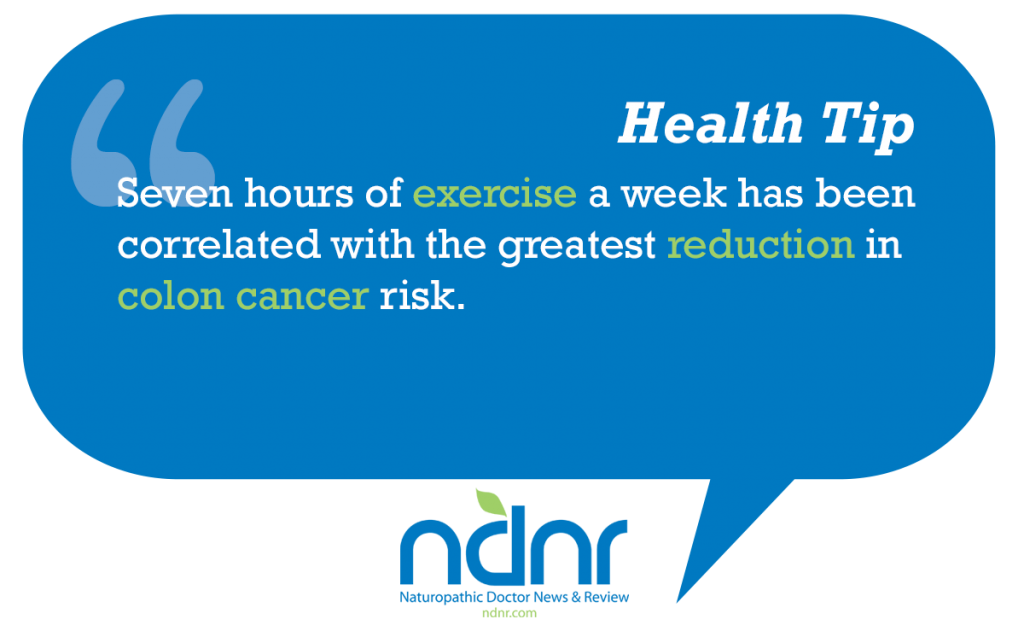Sarah Skolout-Redick, ND
Colon cancer is the second leading cause of cancer-related deaths in the U.S. However, it also has many modifiable risk factors, and various strategies have been developed to detect and prevent colon cancer.
When confronted with a patient concerned about developing colon cancer, it is encouraging to know that simple lifestyle modifications can dramatically reduce the risk of the disease. Research has clearly demonstrated that physical activity can prevent the occurrence of colon cancer through a number of proposed mechanisms. Exercise also improves quality of life in colon cancer patients and reduces colon cancer-related mortality. NDs are well equipped to educate patients on the benefits of exercise and colon cancer prevention. Here are the answers to some common questions patients might ask.
How Does Exercise Prevent Colon Cancer?
How exercise prevents colon cancer is still not entirely clear, but there are a number of proposed mechanisms. Physical activity may alter the biochemistry of the colon and improve resistance to harmful substances. Increased levels of insulin-like growth factor (IGF-1) have been correlated with increased colon cancer rates. Exercise reduces IGF-1 levels over time. Exercise also increases IGF-binding protein, which limits the effects of IGF-1 on the colon. Prostaglandins have been linked to colon cancer, and exercise reduces levels of prostaglandins in the body. Lower levels of C-reactive protein and high levels of anti-inflammatory cytokines are seen in people who exercise regularly, further supporting the role of physical activity in reducing inflammation.
It also has been demonstrated that people who exercise tend to drink more water than sedentary people. Water may decrease transit time through the gut and dilute possible carcinogens. Increased water intake has been shown, independently, to reduce colon cancer risk, so exercisers may be drawing on this benefit, as well.
Exercisers are less likely to gain weight, and when combined with diet, are more likely to lose weight. Obesity has been correlated with colon cancer, and people who lose weight reduce their risk. Weight loss may contribute to the prevention of colon cancer through exercise; however, several studies have demonstrated reduced risk with exercise alone. Weight loss may not be necessary to achieve the benefits of exercise, and this can be encouraging to patients who struggle with weight issues.
How Much Do I Have to Exercise?
An analysis of several studies revealed that the median reduction for colon cancer risk is an average of 20%-40%. However, there is a dose-related response, meaning that more exercise leads to a greater reduction in colon cancer risk.
Two specific studies determined that there are also differences in how men and women respond to exercise. Moderate to high levels of weekly physical activity are needed to reduce colon cancer risk. For example, men who exercise at least 30 minutes per day five days a week reduce their colon cancer risk by 50%, compared to sedentary men. Women who exercise more than 5 hours per week reduce their risk by 45%. Overall, 4 hours a week of physical activity plays a significant role in the prevention of colon cancer. Seven hours of exercise a week has been correlated with the greatest reduction in colon cancer risk.
Am I Too Old to Exercise?
Many patients are not concerned about colon cancer until they reach middle age or older, and may question whether starting an exercise program later in life will be beneficial. Many of the studies conducted on colon cancer prevention have been in older adults. They demonstrate reduced colon cancer risk in people who begin and maintain an exercise program, regardless of previous activity level.
Conduct a thorough physical exam and perform a fitness assessment on any patient desiring to begin an exercise program. Patients of any age without contraindications to exercise, such as unstable cardiac, metabolic or orthopedic conditions, can participate in physical activity and help prevent colon cancer.
What Type of Exercises Should I Do?
Although studies clarifying the best types of exercises to prevent colon cancer are lacking, aerobic activity appears to be the most beneficial. Vigorous walking, jogging/running, lap swimming, tennis, bicycling, aerobics and dancing have been shown to contribute to the reduction of cancer risk. The ideal exercise program includes activities that are enjoyable, fit into the patient’s schedule and can be adapted to different seasons. An exercise prescription should include the type, duration, intensity and frequency of the exercise.
The ND should discuss potential obstacles to exercising and develop a plan to help maintain motivation. Frequent follow-up visits are key to maintaining exercise programs long term. Joining a class or working with a personal trainer may be beneficial for some patients. Overall, patients are more likely to exercise if a physician discusses the importance of exercise and creates an individualized plan.
If I Get Colon Cancer, Should I Keep Exercising?
Exercise improves quality of life and may lead to decreased mortality in colon cancer patients. Patients who maintain some level of physical activity during cancer treatment experience fewer side effects. Colon cancer patients should be encouraged to participate in a low- to moderate-intensity exercise program. This could include continuing daily activities, such as vacuuming and washing dishes; participation in a group exercise setting, such as those offered by many cancer treatment centers; or maintaining previous activities at a lower intensity, such as walking or biking.
Overall, exercise is an essential component in the prevention of colon cancer. NDs have the tools to educate patients on the importance of physical activity. Discussing prevention strategies can be a part of routine colon cancer screening visits and integrated into general health appointments.
Example Exercise Prescription for Preventing Colon Cancer
Type of exercise: Vigorous walking, biking, swimming, jogging, joining a sports team or club. Encourage patients to participate in an activity that they enjoy and can do regularly. Think about how weather may affect exercise and have an alternate plan.
Intensity: Moderate- to high-intensity activity.
Duration: 30-60 minutes a day. A portion of this time can be split into daily activities, such as walking up stairs or across parking lots. However, it is best if the majority is completed in a single session.
Frequency: Five or more days a week. The goal is to accumulate 4 to 7 hours of exercise a week.
 Sarah Skolout-Reddick, ND resides in the Vail Valley of Colorado. She is a graduate of Bastyr University and a certified health fitness specialist through the American College of Sports Medicine. Her interests are in therapeutic exercise, nutrition and physical medicine. She brings a naturopathic approach to the growing field of sports medicine. Contact her at sarah. [email protected] or 970-368-0777.
Sarah Skolout-Reddick, ND resides in the Vail Valley of Colorado. She is a graduate of Bastyr University and a certified health fitness specialist through the American College of Sports Medicine. Her interests are in therapeutic exercise, nutrition and physical medicine. She brings a naturopathic approach to the growing field of sports medicine. Contact her at sarah. [email protected] or 970-368-0777.
References
American College of Sports Medicine. ACSM’s Resource Manual for Guidelines for Exercise Testing and Prescription (5th ed). Baltimore, 2006, Lippincott, Williams & Wilkins.
Centers for Disease Control and Prevention: Cancer – Fast Facts about Colorectal Cancer, www.cdc.gov/cancer/colorectal/basic_info/facts.htm. Accessed Aug 28, 2008. Centers for Disease Control and Prevention: Cancer – Reducing Personal Colorectal Cancer Risk, http://www.cdc.gov/cancer/colorectal/basic_info/reducing_risk.htm. Accessed Aug 28, 2008.
Chao A et al: Amount, type, and timing of recreational physical activity in relation to colon and rectal cancer in older adults: the Cancer Prevention Study II Nutrition Cohort, Cancer Epidemiol Biomarkers Prev 13(12):2187-2195, 2004.
Scott S: Exercise for life: cancer prevention with exercise and lifestyle modifications, ACSM’s Health and Fitness Journal 12:35-40, 2008.
Trojian T et al: Exercise and colon cancer: primary and secondary prevention, Current Sports Medicine Reports 6(12):120-124, 2007.





